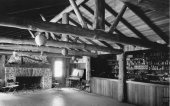While I am the new guy I am well aware that the following is most probably been done before, there might be some who get something from my research over the years. I apologize for the redundancy
Ray.
ELDORADOVILLE
The San Gabriel Mountains of Southern California are a part of a great barrier that separates the Mojave Desert from the coastlands. They are a transverse range, meaning that they run east west as opposed to the more usual north-south configuration. While James Marshall is credited with the discovery of gold in California on the American River in 1847, it was in the San Gabriel Mountains where the actual first discovery took place. March 1842, in Placerita Canyon, in the Saugus Nehall area, Francisco Lopez y Arballo, while gathering wild onions from around an old oak, discovered gold particles clinging to the roots of the bulbs. In November of 1842 the first gold from the Placerita placers was shipped to the U.S. Mint in Philadelphia. It is estimated that $80,000 in gold was recovered as a result of this discovery
The most colorful and historically rich area of all these mountains is the San Gabriel Canyon. Most of this history is about the search for gold, boomtowns, bad men, murders and flood that completely wipe out a town. Everything from Indian pictographs to Navel weapons testing has taken place here.
Gold was first discovered in the East Fork in 1855. Found in placers, early prospectors could pan as much as six to seven dollars a day. By 1859 the Santa Anita Mining Company was established and Eldoradoville began to boom. Starting as a tent town, by 1860 is was permanent enough that there were 400 votes cast for Abraham Lincoln. The town had three general stores, half a dozen saloons and dance halls. There was quite a group of interesting folks here not the least of which were; George Trogden, who had a mail and supply cabin at Iron Fork and is buried there. “Twitchlip Kelly”, “PegLeg Bill Coynes”, Old Man Armstrong, Uncle Jimmy Grayson, “One-Eyed Mountain Charlie”, Soldier Thompson and Two Gun Don Kosenkrantz. Oliver Justice was buried in a coffin he had hand-hewn himself in his pre-dug grave above Iron Fork. John Robb made his fortune sluicing gold from the sawdust swept from the saloon floors.
Hydraulic mining was attempted and H.C. Roberts competed with William G. Ferguson to see who could be the first to bring ditch water down the canyon to the monitors, neither one was successful. The San Gabriel district had a total production, 1848-1957, of about 165,000 ounces of gold. In 1862, the town of Eldoradoville was completely erased by flood, nothing remained. No sketch or photograph of the town has survived. Locals tell a story of a miner and mule taken by the same flood along with several sacks of gold. There is a rumor of a safe being washed away as well. Neither the miner, his mule nor the safe were ever seen again. The town was never rebuilt.
Some history of the San Gabriels
-
Hikin_Jim

- Posts: 4688
- Joined: Thu Sep 27, 2007 9:04 pm
Interesting, RP.
What is that citation from?
HJ
What is that citation from?
HJ
-
rpmiller

- Posts: 11
- Joined: Tue Dec 31, 2013 1:03 pm
Actually it is a compilation from several sources. My text book from a California History class at Citrus College, California, A History by Andrew F. Rolle, 1963. Pg 207.
A Guidebook of the San Gabriel Mountains of California by Russ Leadabrand revised 1964 pgs 32-35.
And oral interviews of local residents I did as a history student for class project.
A Guidebook of the San Gabriel Mountains of California by Russ Leadabrand revised 1964 pgs 32-35.
And oral interviews of local residents I did as a history student for class project.
-
rpmiller

- Posts: 11
- Joined: Tue Dec 31, 2013 1:03 pm
-
Hikin_Jim

- Posts: 4688
- Joined: Thu Sep 27, 2007 9:04 pm
Interesting. Old cabins I suppose. There's still a lot of stuff just east of there in Coldwater Canyon. It used to be they had no problem with hikers transiting, but I guess some problems must have occurred. The road down Coldwater is now closed to hikers. Weird too. There can't be much traffic. It's hard to get back in there. Trail obliterated beyond Heaton Saddle.
HJ
HJ
-
outwhere

- Posts: 323
- Joined: Sun Jan 25, 2009 5:40 pm
Greetings Ray - very interesting and I can never get enough historical information when it comes to the San Gabriel Mountains - 'so brinnnnng it on' sounds good in my ears !rpmiller wrote: ...that the following is most probably been done before, there might be some who get something from my research over the years. I apologize for the redundancy
Ray.
I kinda remember reading about Eldoradoville, maybe in one of John Robinson's book, but your post resparked the fun of conjuring up what it musta been like in the canyon with a half dozen saloons and lots of wild characters.
Cool structure pics too! That piano
Was this photo taken in 1964?
.jpg)
Thanks for the post - it amazing to think how much activity has gone on in the San Gabriels...
-
rpmiller

- Posts: 11
- Joined: Tue Dec 31, 2013 1:03 pm
All the pics are 1964. I have always wondered about the window with the bars.
-
tracker
- Posts: 199
- Joined: Wed Jul 25, 2012 11:20 pm
It looks like a Forest Service building. That yellow sign looks like the "No Trespassing" signs they would put on abandoned buildings after they got legal title for them. The BLM still does that but the wording is a little different.
 Bears?
Bears?
Black bears were "stocked" at Crystal Lake in the '30. I'm sure they could have made it that low in just a few years. I would have bars on anything I had in bear country.
I have always wondered about the window with the bars.
Black bears were "stocked" at Crystal Lake in the '30. I'm sure they could have made it that low in just a few years. I would have bars on anything I had in bear country.
-
Sewellymon
- Posts: 109
- Joined: Tue Feb 12, 2008 8:55 pm
what Hiking Jim said...
Coldwater Canyon was a great place to hike through. I'd do loop trips taking the Heaton Canyon trail.... would camp maybe 1/2 mile above Widman Ranch under some great oaks and go up to the old mines and San Antonio Ridge...
Coldwater Canyon was a great place to hike through. I'd do loop trips taking the Heaton Canyon trail.... would camp maybe 1/2 mile above Widman Ranch under some great oaks and go up to the old mines and San Antonio Ridge...

.jpg)
.jpg)
.jpg)
.jpg)